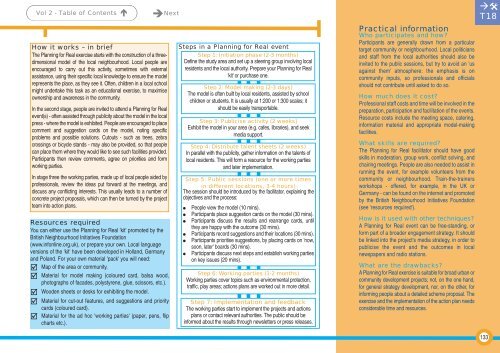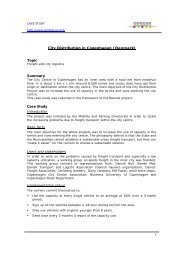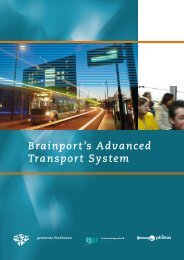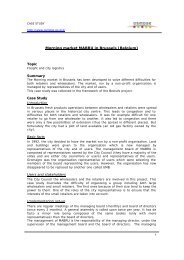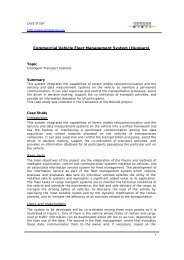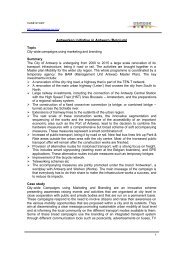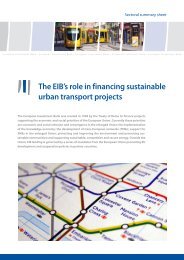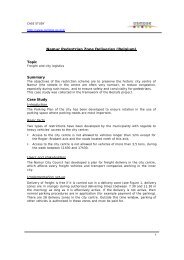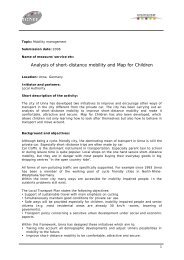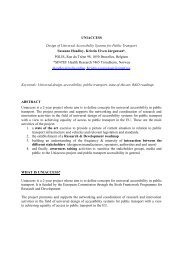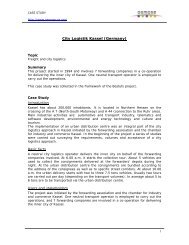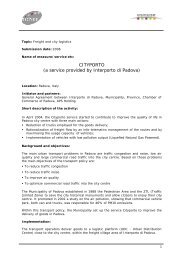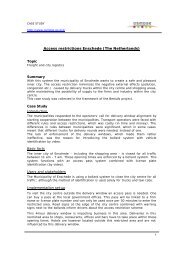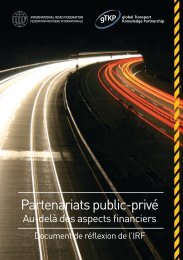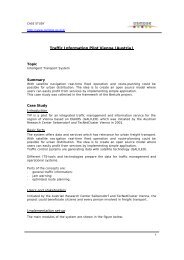Successful transport decision-making - Osmose
Successful transport decision-making - Osmose
Successful transport decision-making - Osmose
You also want an ePaper? Increase the reach of your titles
YUMPU automatically turns print PDFs into web optimized ePapers that Google loves.
Vol 2 - Table of Contents Next Practical information<br />
Who participates and how?<br />
How it works – in brief<br />
The Planning for Real exercise starts with the construction of a threedimensional<br />
model of the local neighbourhood. Local people are<br />
encouraged to carry out this activity, sometimes with external<br />
assistance, using their specific local knowledge to ensure the model<br />
represents the place, as they see it. Often, children in a local school<br />
might undertake this task as an educational exercise, to maximise<br />
ownership and awareness in the community.<br />
In the second stage, people are invited to attend a Planning for Real<br />
event(s) - often assisted through publicity about the model in the local<br />
press - where the model is exhibited. People are encouraged to place<br />
comment and suggestion cards on the model, noting specific<br />
problems and possible solutions. Cutouts - such as trees, zebra<br />
crossings or bicycle stands - may also be provided, so that people<br />
can place them where they would like to see such facilities provided.<br />
Participants then review comments, agree on priorities and form<br />
working parties.<br />
In stage three the working parties, made up of local people aided by<br />
professionals, review the ideas put forward at the meetings, and<br />
discuss any conflicting interests. This usually leads to a number of<br />
concrete project proposals, which can then be turned by the project<br />
team into action plans.<br />
Resources required<br />
You can either use the Planning for Real 'kit' promoted by the<br />
British Neighbourhood Initiatives Foundation<br />
(www.infonline.org.uk), or prepare your own. Local language<br />
versions of the 'kit' have been developed in Holland, Germany<br />
and Poland. For your own material 'pack' you will need:<br />
Map of the area or community.<br />
Material for model <strong>making</strong> (coloured card, balsa wood,<br />
photographs of facades, polystyrene, glue, scissors, etc.).<br />
Wooden sheets or desks for exhibiting the model.<br />
Material for cut-out features, and suggestions and priority<br />
cards (coloured card).<br />
Material for the ad hoc 'working parties' (paper, pens, flip<br />
charts etc.).<br />
Steps in a Planning for Real event<br />
Step 1: Initiation phase (2-3 months)<br />
Define the study area and set up a steering group involving local<br />
residents and the local authority. Prepare your Planning for Real<br />
'kit' or purchase one.<br />
Step 2: Model <strong>making</strong> (2-3 days)<br />
The model is often built by local residents, assisted by school<br />
children or students. It is usually at 1:200 or 1:300 scales; it<br />
should be easily <strong>transport</strong>able.<br />
Step 3: Publicise activity (2 weeks)<br />
Exhibit the model in your area (e.g. cafes, libraries), and seek<br />
media support.<br />
Step 4: Distribute talent sheets (2 weeks)<br />
In parallel with the publicity, gather information on the talents of<br />
local residents. This will form a resource for the working parties<br />
and later implementation.<br />
Step 5: Public sessions (one or more times<br />
in different locations, 3-4 hours)<br />
The session should be introduced by the facilitator, explaining the<br />
objectives and the process:<br />
<br />
<br />
<br />
<br />
<br />
<br />
People view the model (10 mins).<br />
Participants place suggestion cards on the model (30 mins).<br />
Participants discuss the results and rearrange cards, until<br />
they are happy with the outcome (30 mins).<br />
Participants record suggestions and their locations (30 mins).<br />
Participants prioritise suggestions, by placing cards on 'now,<br />
soon, later' boards (30 mins).<br />
Participants discuss next steps and establish working parties<br />
on key issues (20 mins).<br />
Step 6: Working parties (1-2 months)<br />
Working parties cover topics such as environmental protection,<br />
traffic, play areas; actions plans are worked out in more detail.<br />
Step 7: Implementation and feedback<br />
The working parties start to implement the projects and actions<br />
plans or contact relevant authorities. The public should be<br />
informed about the results through newsletters or press releases.<br />
Participants are generally drawn from a particular<br />
target community or neighbourhood. Local politicians<br />
and staff from the local authorities should also be<br />
invited to the public sessions, but try to avoid an 'us<br />
against them' atmosphere: the emphasis is on<br />
community inputs, so professionals and officials<br />
should not contribute until asked to do so.<br />
How much does it cost?<br />
Professional staff costs and time will be involved in the<br />
preparation, participation and facilitation of the events.<br />
Resource costs include the meeting space, catering,<br />
information material and appropriate model-<strong>making</strong><br />
facilities.<br />
What skills are required?<br />
The Planning for Real facilitator should have good<br />
skills in moderation, group work, conflict solving, and<br />
chairing meetings. People are also needed to assist in<br />
running the event, for example volunteers from the<br />
community or neighbourhood. Train-the-trainers<br />
workshops - offered, for example, in the UK or<br />
Germany - can be found on the internet and promoted<br />
by the British Neighbourhood Initiatives Foundation<br />
(see 'resources required').<br />
How is it used with other techniques?<br />
A Planning for Real event can be free-standing, or<br />
form part of a broader engagement strategy. It should<br />
be linked into the project's media strategy, in order to<br />
publicise the event and the outcomes in local<br />
newspapers and radio stations.<br />
What are the drawbacks?<br />
A Planning for Real exercise is suitable for broad urban or<br />
community development projects; not, on the one hand,<br />
for general strategy development, nor, on the other, for<br />
informing people about a detailed scheme proposal. The<br />
exercise and the implementation of the action plan needs<br />
considerable time and resources.<br />
<br />
T18<br />
133


